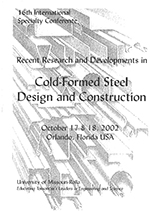Session Dates
17 Oct 2002
Abstract
The design of cold-formed steel webs in flexure is governed by section B2.3 of the AISI Specification. Harmonization of the AISI (1996) Specification with the Canadian Standard (S136 1994), for the development of the new North American Specification (NAS 2001) has brought to light shortcomings in both the U.S. and Canadian documents and lead to the adoption of an interim design approach in the NAS (2001). The interim approach employs the AISI (1996) rules for one class of members and the S136 (1994) rules for a second class. Assessment of the resulting method with existing bending tests on Cees and Zees reveals significant "scatter" in the prediction of cold-formed steel beams and highlights problems associated with ignoring web/flange interaction, as is done in current methods. Determination of the "classes" in which the two methods are employed is presented, as is the rejection of a specific exclusion for sheathed members which was proposed during the development of the interim method. Finally, the practical implications of the new design rules are explored in a design example with the step discontinuity in strength between the "classes" highlighted.
Department(s)
Civil, Architectural and Environmental Engineering
Research Center/Lab(s)
Wei-Wen Yu Center for Cold-Formed Steel Structures
Meeting Name
16th International Specialty Conference on Cold-Formed Steel Structures
Publisher
University of Missouri--Rolla
Document Version
Final Version
Rights
© 2002 University of Missouri--Rolla, All rights reserved.
Document Type
Article - Conference proceedings
File Type
text
Language
English
Recommended Citation
Schafer, Benjamin W. and Trestain, T. W. J., "Interim Design Rules for Flexure in Cold-formed Steel Webs" (2002). CCFSS Proceedings of International Specialty Conference on Cold-Formed Steel Structures (1971 - 2018). 3.
https://scholarsmine.mst.edu/isccss/16iccfss/16iccfss-session2/3
Interim Design Rules for Flexure in Cold-formed Steel Webs
The design of cold-formed steel webs in flexure is governed by section B2.3 of the AISI Specification. Harmonization of the AISI (1996) Specification with the Canadian Standard (S136 1994), for the development of the new North American Specification (NAS 2001) has brought to light shortcomings in both the U.S. and Canadian documents and lead to the adoption of an interim design approach in the NAS (2001). The interim approach employs the AISI (1996) rules for one class of members and the S136 (1994) rules for a second class. Assessment of the resulting method with existing bending tests on Cees and Zees reveals significant "scatter" in the prediction of cold-formed steel beams and highlights problems associated with ignoring web/flange interaction, as is done in current methods. Determination of the "classes" in which the two methods are employed is presented, as is the rejection of a specific exclusion for sheathed members which was proposed during the development of the interim method. Finally, the practical implications of the new design rules are explored in a design example with the step discontinuity in strength between the "classes" highlighted.



